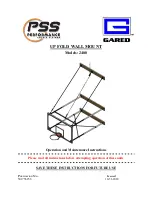
2-4
11236 Satellite Blvd. Orlando, FL 32837 Tel.: (407) 859-9317 Fax: (407) 850-6978 www.strongparachutes.com
Strong Enterprises Owner’s Manual. TNT System -
Rev. A 1/16
Malfunctions are divided into two categories: total malfunctions and partial malfunctions.
A
total malfunction
is the failure to initiate deployment of the main parachute. Reasons for
a total malfunction may include, but are not limited to, a lost or floating ripcord handle a hard
ripcord pull or non deployment of the drogue. Because you will be at or near terminal velocity,
a total malfunction requires immediate action. The proper procedure is to promptly activate the
reserve while remaining in a stable, belly-to-earth position.
A
partial malfunction
is a partial deployment of the main parachute. Partial malfunctions can
be further subcategorized as high-speed and low-speed. High-speed malfunctions (drogue-in-tow,
bag lock, streamer) require quick thinking and immediate action. Low-speed malfunctions (hung
slider, line over, broken lines, torn cells and any spinning malfunction) typically allow more time
to assess and react to the circumstances. If the decision is made to cutaway from a malfunctioning
main parachute and deploy the reserve parachute, use the following procedures:
1. Look at and grasp the cutaway handle with your right hand.
2. Look at and grasp the reserve ripcord handle with your left hand.
3. Peel the cutaway handle from the main lift web and pull to full arm extension.
4. Confirm the canopy has been completely released.
5. Pull the reserve ripcord handle to full arm extension.
Consult the training materials of the Strong Enterprises Tandem
Instructor Certification Course or contact Strong Enterprises directly
for more detailed emergency procedures.
2.2 Harness Fitting
For more detailed instruction consult the Strong Enterprises Tandem Instructor Certification
Course.
2.2.1 Instructor Harness
1. Ensure that all straps are adjusted all the way out and not twisted.
2. Unhook B-12 snaps and let the leg straps hang free.
3. Lift rig up by its main lift webs and put it on as you would a coat.
4. Thread chest strap through friction adapter and tighten until both main lift webs are parallel
with each other. Be sure it is not routed through the reserve ripcord handle.
5. Fold and stow excess chest strap in elastic keeper.
6. Route leg straps around your legs, removing all twists and fasten B-12 snaps to their V-rings.
7. Tighten leg straps evenly until they are snug but not uncomfortable and stow excess webbing
in elastic keepers.
8. Tighten main lift webbing straps evenly until they are snug but not uncomfortable. The
harness should now be fitted and snug.
9. Stow excess webbing of all adjustable straps.
















































